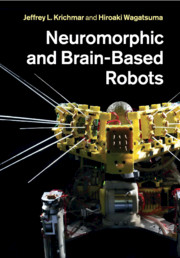Book contents
- Frontmatter
- Contents
- Contributors
- Preface
- Part I Introduction
- Part II Neuromorphic robots: biologically and neurally inspired designs
- Part III Brain-based robots: architectures and approaches
- 5 The RatSLAM project: robot spatial navigation
- 6 Evolution of rewards and learning mechanisms in Cyber Rodents
- 7 A neuromorphically inspired architecture for cognitive robots
- 8 Autonomous visuomotor development for neuromorphic robots
- 9 Brain-inspired robots for autistic training and care
- Part IV Philosophical and theoretical considerations
- Part V Ethical considerations
- Index
- References
5 - The RatSLAM project: robot spatial navigation
from Part III - Brain-based robots: architectures and approaches
Published online by Cambridge University Press: 05 February 2012
- Frontmatter
- Contents
- Contributors
- Preface
- Part I Introduction
- Part II Neuromorphic robots: biologically and neurally inspired designs
- Part III Brain-based robots: architectures and approaches
- 5 The RatSLAM project: robot spatial navigation
- 6 Evolution of rewards and learning mechanisms in Cyber Rodents
- 7 A neuromorphically inspired architecture for cognitive robots
- 8 Autonomous visuomotor development for neuromorphic robots
- 9 Brain-inspired robots for autistic training and care
- Part IV Philosophical and theoretical considerations
- Part V Ethical considerations
- Index
- References
Summary
Introduction
Rats are superior to the most advanced robots when it comes to creating and exploiting spatial representations. A wild rat can have a foraging range of hundreds of meters, possibly kilometers, and yet the rodent can unerringly return to its home after each foraging mission, and return to profitable foraging locations at a later date (Davis, et al., 1948). The rat runs through undergrowth and pipes with few distal landmarks, along paths where the visual, textural, and olfactory appearance constantly change (Hardy and Taylor, 1980; Recht, 1988). Despite these challenges the rat builds, maintains, and exploits internal representations of large areas of the real world throughout its two to three year lifetime. While algorithms exist that allow robots to build maps, the questions of how to maintain those maps and how to handle change in appearance over time remain open.
The robotic approach to map building has been dominated by algorithms that optimize the geometry of the map based on measurements of distances to features. In a robotic approach, measurements of distance to features are taken with range-measuring devices such as laser range finders or ultrasound sensors, and in some cases estimates of depth from visual information. The features are incorporated into the map based on previous readings of other features in view and estimates of self-motion. The algorithms explicitly model the uncertainty in measurements of range and the measurement of self-motion, and use probability theory to find optimal solutions for the geometric configuration of the map features (Dissanayake, et al., 2001; Thrun and Leonard, 2008). Some of the results from the application of these algorithms have been impressive, ranging from three-dimensional maps of large urban structures (Thrun and Montemerlo, 2006) to natural environments (Montemerlo, et al., 2003).
- Type
- Chapter
- Information
- Neuromorphic and Brain-Based Robots , pp. 87 - 108Publisher: Cambridge University PressPrint publication year: 2011

